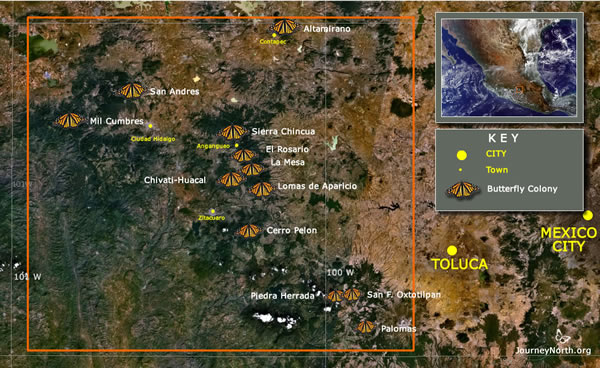| Dear Friends,
It is getting drier and drier every day, since our days continue to be rather very sunny, with somehow cloudy afternoons, but without any rain at all, which might be typical for this time, in past years. Meanwhile, local people in Angangueo assure having seen lots of monarchs passing by and heading northwards, specially on February 28th, March 1st, and 2nd, which indeed may show a very first group of monarchs intending to start the imminent leaving within the coming weeks. I need to tell you while driving from Querétaro to Angangueo on March 1st we saw perhaps a couple dozen monarchs flying north! They were already 80 km (50 miles) from the sanctuary! SIERRA CHINCUA SANCTUARY Along the way, still lots of remaining fallen trees and cleaning up activities due to the damages caused by the storm in March 2016, result still painful to see. Conservationists and Tag Collectors comment, on passing by and looking at a certain kind of fungi, that indeed, a decomposing process at the forest is going on due to the fallen trees on the soil as result of the terrible storm last year. The Colony now has re-located and densily concentrated in “Cuala” Site. As we reached the center of the colony, we got paralyzed. One could not believe one’s eyes. I last saw this huge population of monarchs in Sierra Chincua, years and years ago now. Perishing on the ground is indeed by this time significant, but totally in accordance with the great population of the Colony now concentrated here. Mating is really active now. Diego, expert guide and monitorer tells us about his experience on collecting tags in the colonies every year. He says guides can find 1, 2 or maximum 3 tags per day at the very core of the colony. EL ROSARIO SANCTUARY. This colony open to visitors in El Rosario Sanctuary has also re-located from their staying last week at “Los Letreros”, moving now onto a forest area between “Llano Cruzado” and “Las Balsitas” sites. The other half of the colony — guides assure — continues way downhill from “Las Balsitas” site. The density of monarchs at this site has now significantly diminished, most clustering in small to medium size clusters, and less on upper half of the Oyamel trunks, other disperse flying around, and a considerable quantity very well concentrated turning their area beautifully orange and gold color. Totally contrasting to last week, the “Llano de los Conejos” is now desserted! No monarchs flying around, neither drinking water on ponds or streams! All quiet at their clusters and Oyamel trunks. Rather normal perishing on the ground with tattered wings, no abdomens, or very thinned ones if any; practically very occasional and scarce groups bursting; scarce nectaring too on their favorite flowers around and rather very quiet at mating. They seem to prefer staying so at the rather slightly cloudy weather of the day. Perhaps the other colony, not open to tourists, down from “Las Balsitas” could be more dense in population? Tag collectors had the most intense collecting activity here, indeed, getting exponential numbers of tags from locals here in Sanctuary El Rosario, compared to a minor tag collection they did at Sierra Chincua, Cerro Pelón, and Piedra Herrada, being the latter smaller colonies. As you all may remember, this season, scientists asked locals at every sanctuary to pick up tags on wings or even dead monarchs themselves, that is, not removing the tags from their wings at all. Triple to four times more tags could have been collected this season at all the four sanctuaries, however, we should indeed wait for the experts on it to give their official results. We all should be anxiously waiting to hear of Monarch Watch’s results on tag collection this season, particularly about the intended purpose of research on tags on wings in monarchs. CERRO PELÓN SANCTUARY The lower altitude at which this community and Sanctuary are located, allow for a wonderful warm, even perhaps kind of semi-tropical weather, and it is here where we visitors can can see milkweed growing, monarchs’ eggs laid, caterpillars and chrysalis! One cannot belive when it is in front of one’s eyes! The very bright, sunny day, allowed us to enjoy an incredible performance of its colony, at flying around, at nectaring, at staying on clusters, in tree trunks and doing wonderful, and very frequent burstings all day long! Mating though not very intense to be seen this day for tourists, has been active all these days, --guides assure-- as it belongs to this time of the season. Locals here, same as locals in El Rosario and Sierra Chincua, assure having seen mating in November and December; too early a time for monarchs to mate and nothing good at all, --they all agree--, mostly due to the rather warm temperatures during all these months, except January, which has been our coldest month so far. The colony this weekend at Cerro Pelón, was simply beautiful and in outstanding performance. Both local and foreign visitors were simply delighted to be here at the weekend. Important to be mentioned is, that, different to El Rosario and Sierra Chincua, where monarchs are seen overwintering in Oyamel forest areas, almost without exception, forests at Cerro Pelón are densely populated by other kinds of trees, like Encino, Aile, Roble, Fresno, Cedro, Trompillo and Mamullo, which shows that monarchs have historically overwintered in this forest of varied species of trees, where the Oyamel species in not the dominant species, resulting interesting to know of experts opinions on this aspect relating monarchs’ habitat. PIEDRA HERRADA SANCTUARY Until next week, Estela Romero |
|
|||||||||||||||||||||||
Copyright Journey North (journeynorth.org). All Rights Reserved.












